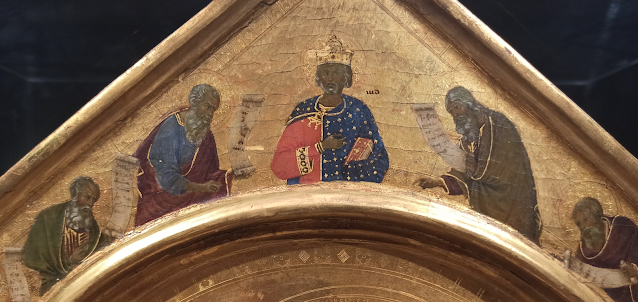I loved this.
This exquisite portable altarpiece was intended for private devotion. For me, it depicts a very moving tenderness and humanity to the traditional Maestà.
Duccio di Buoninsegna (1278-1319) was a key early Sienese painter. Duccio influenced all those artists that followed him (just as Giotto influenced Florentine artists).
According to my art history book:
Duccio is not as innovative in style or technique as Giotto, who was his contemporary, but he is a better narrator of events.
I think this can be seen in the way the Madonna and Child are musing over each other — which fills the main panel. The painting has a warmth which I found absolutely beautiful. As with the Met, the Christ seems to be moving towards his mother for an embrace. The traditional Maestà seemed to show the Madonna pointing to Christ. Here (see below) she is wrapping her arms around him.
The Byzantine tradition can be seen in the long, straight noses, small mouths, and almond-shaped eyes (which can give an inscrutable expression). Having said that it shows just how ornate and beautiful Byzantine art is on its own terms.
 |
| The decorative gilding of the Madonna’s headscarf is just delicious. |
✲✲✲
On the left, St. Dominic appears.
On the right, St. Aurea, an early martyr killed by drowning.
 |
| In the gable above is King David, accompanied by Old Testament prophets holding their prophesies concerning Mary’s virginity and Christ’s birth. |


The way you described the painting gave it a full life
ReplyDelete